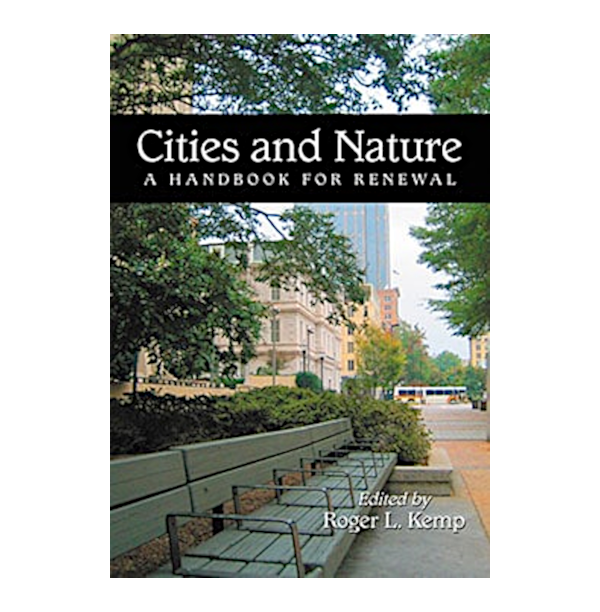Description
Cities and towns across the United States are working to restore nature and increase green space as a means to improve quality of life and enhance economic conditions.
In Cities and Nature, editor Roger Kemp has gathered articles and essays from more than 50 leading practitioners on all aspects of what he has termed the "back-to-nature" movement in downtown revitalization.
The case studies illustrate the work of cities and towns in four major areas: creating, protecting, preserving, and restoring nature.
The case studies come from cities across the nation. Differing geographically, politically and culturally, these cities offer a variety of ideas and inspirations while sharing a commitment to an urban environment enhanced by nature.
Key essays and case studies include:
- The economic benefits of parks and open space
- Lessons in creating urban parks on existing public facilities
- Hartford, CT, revives its downtown riverfront
- Lafayette, IN, uses public plazas to revive main streets
- Petaluma, CA, reorients its downtown around a river
- St. Louis, MO, park creates new community green downtown
- St. Paul, MN, revives its inner-city riverfront area
- San Francisco, CA, transforms industrial site into open space and trails
- Silver Spring, MD, turns old railroad corridors into public trails
- West Des Moines, IA, turns floodplain into regional park and open space
Table of Contents
- Part 1: Cities and Nature
- A New Approach to Managing Growth
- Environmental Management Systems
- Creating “New” Main Streets in Our Cities
- Development for People and Wildlife
- The Economic Benefits of Parks and Open Space
- Part II: The Best Practices
- Atlanta Builds Parks to Create Open Spaces
- Baltimore Uses Linear Trails to Link Neighborhoods to Harbor District
- Boston, Other Cities, Create Urban Parks on Existing Public Facilities
- Cambridge Designs Open Spaces to Improve Downtown Living
- Charlottesville, Other Cities, Restore Their Watersheds
- Chattanooga Creates Public Parks and Greenways
- Chesterfield County Protects Nature to Preserve Quality-of-Life
- Chicago Creates "Green" Infrastructure
- Denver Networks with Greenways and Trails
- Fairfield Uses Town Green to Preserve Nature Downtown
- Fort Collins Takes Steps to Protect and Preserve Its Climate
- Gainesville and Hall County Work to Preserve Watershed Areas
- Grand Forks Rebuilds Downtown with Open Spaces and Walkways
- Hampton Creates Environmental Center While Preserving Open Space
- Harmony: America’s Latest Conservation Community
- Hartford Revives Its Riverfront
- Irvine Turns Military Base into Park and Nature Preserve
- Lafayette, Other Cities, Use Public Plazas to Revive Main Streets
- Lake Worth Restores Its Public Beaches
- Lancaster Revitalizes Inner-City Park
- Miami Beach, Other Cities, Shore Up Their Coastlines
- Minneapolis and Saint Paul, Other Cities, Guide Growth to Improve the Environment
- New York City’s Old Railroad Tracks Become Hidden Garden
- Northampton County Combines Economic Development with Environmental Protection
- Petaluma Reorients Its Downtown Around a River
- Philadelphia and Camden Restore Their Riverfronts
- Phoenix, Other Cities, Use GIS to Prevent Urban Sprawl
- Port Aransas, Other Cities, Benefit from Wildlife Conservation Trails
- Portland Protects Its Open Spaces
- Portland Pursues Balance Between Its Economy and Environment
- Riverhead and Mattituck Take Steps to Protect Nature
- Saint Louis Park Creates a New Community Green Downtown
- Saint Paul Revives Its Inner-City Riverfront Area
- San Francisco Transforms Industrial Site into Open Space and Trails
- San Jose, Other Cities, Initiate Corridor Preservation
- San Rafael, Other Cities, Restore Urban Parks with Private Donations
- Seattle, Other Cities, Encourage Development of "Green" Buildings
- Seattle Highway Is Designed to Protect Wildlife
- Silver Spring, Other Cities, Turn Old Railroad Corridors into Public Trails
- West Des Moines Turns Floodplain into Regional Park and Open Space
- Part III: The Future
- The Eco-Economic Revolution Is Here to Stay
- Economic Growth Without Destruction
- The Importance of Landscaping in the Urban Environment
- Urban Parks and Public Plazas Return to the Inner-City
- Nature and the Human Spirit
- Part IV: Resources
- Regional Resource Directory
- National Resource Directory
About the Editor
Roger L. Kemp, PhD, ICMA-CM, is Distinguished Adjunct Professor at the Edward S. Ageno School of Business of Golden Gate University and a career city manager for 25 years in California, New Jersey, and Connecticut.
His other books include, Main Street Renewal, Small Town Economic Development, and Cities and the Arts.

